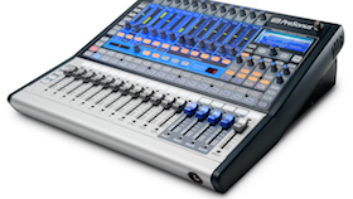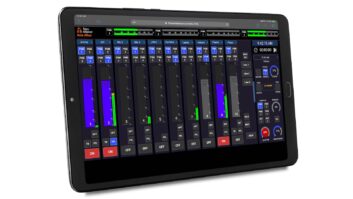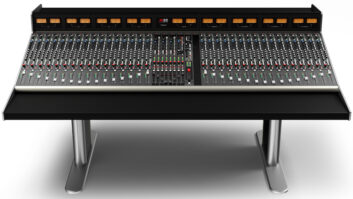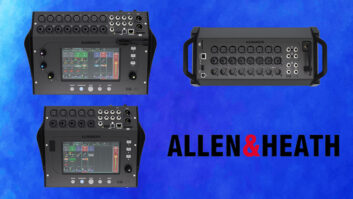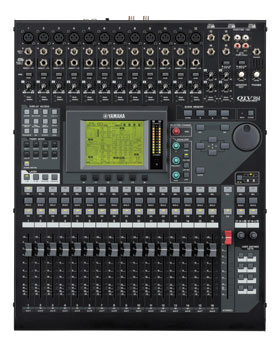
The 01V96i has 12 XLR mic inputs with phantom power switched in banks of four.
Yamaha’s 01V96i mixing console expands upon the success of its predecessors (the 01V and 01V96), performing double-duty for use in live sound mixing and DAW recording. Featuring a variety of analog and digital I/O, the 01V96i maintains its 40-channel input capacity (32 mono, plus 4 stereo) even at sample rates up to 96 kHz, employing 24-bit/96k converters and 32-bit internal processing. Seventeen motorized faders allow multi-layer control of input channels, output buses and DAW faders, while comprehensive onboard DSP is used to create a wide variety of dynamics, EQ and effects processing.
From the Top
The 01V96i’s top panel features 16 analog inputs, 12 of which have XLR mic inputs with phantom power and pad, balanced TRS line inputs, and TRS inserts (tip=send, ring=return). Inputs 13 through 16 are TRS line inputs only, without inserts. Each channel strip features gain control, SEL, SOLO and ON buttons plus a 100mm motorized fader. RCA jacks are provided for 2-track out and 2-track return. Inputs 15/16 may be switched to accept the 2-track return, enabling it to be re-routed without physical patching—very convenient. A phones jack with dedicated volume control powers any headphones to comfortable levels (including my very old AKG K 240s).
The rear panel hosts TRS Monitor and Omni outputs, balanced XLR outs for the Stereo Master and phantom power switched in three banks of four (you’ll need a paper clip or small screwdriver to access these switches). Also found on the rear panel are RCA jacks for SPDIF I/O, ADAT optical I/O (eight channels), word clock I/O, MIDI in/out/thru and a USB 2 port carrying 16 I/Os for DAW recording and playback. A single YGDAI (Yamaha General Digital Audio Interface) slot facilitates expansion.
The 01V96i’s architecture defaults analog inputs 1-16 on layer 1, digital inputs 17-32 on layer two, Aux and Bus masters on layer three and DAW fader control on layer four. Digital inputs can be USB DAW returns 1-16, ADAT inputs 1-8, or one of a variety of YGDAI cards, including ADAT, AES/EBU, TDIF, Aviom A-Net, A/D, etc. The beauty of the architecture is that you can route any input to any channel, so if you’d prefer to have the DAW returns on layer 1 and the analog inputs on layer 2, it’s easy to switch them. These settings are global and are not stored with scenes. Inputs can be routed to any of eight buses, the stereo bus or a direct out, and can be named to avoid confusion when switching from layer to layer.
Processing
All 32 input channels have identical DSP, including 4-band parametric EQ, dynamics (gate and compressor), bus routing, eight aux sends, phase invert, channel delay and software insert, which enables any of the console’s onboard effects to be dedicated to an input channel, a really nice option; more on that later.

The 01V96i will operate as a DAW interface and controller.
The remaining eight inputs are stereo effect returns 1 through 4. Default surface controls for the returns are minimal: two sets of SEL, SOLO, ON and a level pot. A shift button is used to alternate access between Stereo In 1 and 2, or Stereo In 3 and 4. The same EQ found on each channel is available on the stereo returns. Effect returns can be re-patched (via software) to unused channels, in which case you get the full feature set of every channel and the 100mm fader. Be aware that it is possible to “mult” the effect returns to input channels and the stereo effect return inputs simultaneously.
The 01V96i’s eight aux sends may be routed to the inputs of the internal effects processors or to any physical output. I patched auxes 1-4 to internal effects 1-4 respectively, and auxes 5-8 to external processors via the Omni outs (I’ll take my PCM70s to the grave). This barely scratches the surface of the 01V96i’s ability to route almost any bus to any output or to multiple outs simultaneously.
Let’s Get Busy
The 01V96i was a pleasure to use in a variety of applications, including simultaneous multitrack recording and stereo mixing. Using the 01V96i as a sound reinforcement mixer is a breeze: Plug in your sources, assign them to the stereo bus and off you go. Input metering is minimal but effective; there’s a green LED for signal present and a red LED to indicate 3 dB below clipping. The preamps are quiet and extend low enough in the frequency range to get the rafters rocking. Having used a multitude of Yamaha digital consoles over the years, it was easy to apply dynamics and EQ, assign and edit effects, and just plain get around.
Onboard effects include EQ and dynamics and time-based effects like you’d find in Yamaha’s SPX2000 processor. The REV-X reverb algorithms are wonderful, and the effects library also includes Yamaha’s VCM (Virtual Circuitry Modeling) “premium” effects such as Comp 276 and Comp 260. Under many circumstances, the library effects will be used in send/return arrangement, but the 01V96i has the ability to assign any of the library effects to any input (or output bus for that matter), and once you hear some of them you’ll want to use them on DAW return channels. I used the 01V96i’s preamps to record a drum kit with a pair of Soundelux U195s as overheads, patched the DAW return tracks through the Comp276S and the result was fantastic—smooth compression that tamed cymbals and mellowed the snare drum while letting the toms and kick pop. I’d have been happy to pay for this plug-in. Channel compression and EQ were equally useful for situations such as transforming a horrible-sounding kick drum into well beyond usable.
DAW Recording and Playback
Using the 01V96i as a DAW interface was a breeze. After installing the supplied driver and connecting the 01V96i to our MacBook Pro it appeared as an I/O device in Pro Tools, Digital Performer, Reason Record and the supplied demo version of Cubase AI. Select the I/O in the software, place the tracks in record and start your engines. Input channels can be assigned to 16 direct outs, which then feed the DAW inputs but the DAW feed can be sourced from any output bus, so, if for example, you wanted to mix two guitar mics to the same DAW track, you could change the DAW feed to the mix bus (Bus 1-8, Aux 1-8, etc.) of your choice.
Yamaha incorporates DAW control “profiles” for various DAWs and User Assignable for those inclined to build their own controller. Choosing the 01V96i’s Remote layer enables fader control, channel on/off, solo and select. DAW control works most elegantly with Cubase AI (no surprise), whereby selecting a channel automatically maps the 01V96i’s pan control to the DAW track. It also enables choosing, enabling and editing plug-ins from the 01V96i. Functions under Pro Tools were similar but not quite as nicely executed. For example, if you want to pan a track in PT you have to select the Channel page of the Remote layer and use the 01V96i’s data wheel to adjust pan. Assigning and editing plug-ins in PT from the 01V96i was a bit clumsy; I could at times assign a plug-in from the surface and other times not. Clicking on a plug-in slot in PT always brought the parameters to the 01V96i for editing.
Able Performer
Over the course of several months using the 01V96i, I put many its features to task, including external clocking via Word and ADAT at a variety of sample rates, snapshot store and recall, insert routing to both internal effects and the hardware insert jacks, and complete re-routing of input channels and output buses. It performed flawlessly and was fun to use. The pre’s and the internal effects sound great, and when you consider its capabilities as a mixer and as a DAW interface, the 01V96i delivers big bang for the buck. It doesn’t come as a surprise that Yamaha has a hit on their hands.
Steve La Cerra is a New York-based recording and live-sound engineer.
Product Summary
COMPANY: Yamaha Pro Audio
PRODUCT: 01V96i Digital Mixing Console
WEBSITE:yamahaproaudio.com
PRICE: $2,699 MSRP
PROS: Sounds great. Extremely versatile routing, Gets along well with others.
CONS: Phantom power switches are difficult to access; DAW control capability varies with software.
Try This
Although the 01V96i’s Remote layer has 16 faders, you can easily manage Pro Tools sessions with higher track counts. My assistant, Lee Petrenka, came up with this: “Under the Tracks Window in Pro Tools, select a grouping of tracks (all the drum tracks, for example). Click on the Track Windows sub-menu and select “Show Only Selected Tracks.” All of the other tracks will disappear from the Mix Window, and the remaining tracks will be mapped to the lowest channels of the 01V96i. Under the Pro Tools Windows menu, choose ‘Memory Locations.’ On the numeric keypad, hit Enter. The New Memory Location window will open. Name the location with a description of the tracks—“Drums,” for example. Under Time Properties click None, and under General Properties click Show/Hide. This creates a Memory Location that is not time-based. Repeat the process for similar track groupings such as Vocals, Guitars etc., naming each accordingly. When you recall the Memory Location, the 01V96i’s faders will automatically snap to control the channels you have assigned to that Memory.”

